Moniek Bloks's Blog, page 32
November 16, 2024
Book News Week 47
Book News week 47 – 18 November – 24 November 2024

Bathild of Francia: Anglo-Saxon Slave, Merovingian Queen, and Abolitionist Saint (Women in Antiquity)
Paperback – 20 November 2024 (US)
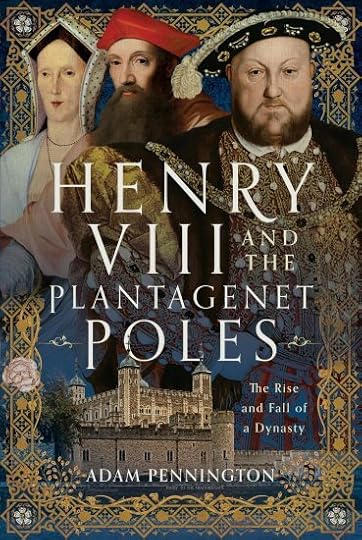
Henry VIII and the Plantagenet Poles: The Rise and Fall of a Dynasty
Hardcover – 24 November 2024 (US)
[no image yet]
The Children of Charles the Second: The Merry Monarch’s Fourteen Bastards
Hardcover – 21 November 2024 (UK)
The post Book News Week 47 appeared first on History of Royal Women.
November 15, 2024
Eleanor of Austria – “Foolishness of love” (Part two)
The Polish match never materialised as Maximilian realised his matchmaking skills were lacking. Especially in the case of Isabella, where he recognised Isabella had married a man who led an “unpleasant and shameful life” with a mistress. And so he decided “to postpone that [match] of Poland until I can recognise my error.”1 During these years, Eleanor was close to her brother Charles, and she attended public events alongside him.
On 23 January 1516, Eleanor’s grandfather, King Ferdinand II of Aragon, died. While he was officially succeeded as King of Aragon by Eleanor’s mother, Joanna, it was to be her brother Charles who would hold the official power. Just two months later, Charles was proclaimed as joint monarch with his mother following an enthronement ceremony in Brussels. It was now time to go to his kingdoms, and it was initially decided that Eleanor would stay in Brussels. However, she did not want to stay and Charles promised she could come. Around this time, it was rumoured that she was in love with the future Frederick II, Elector Palatine, who was in Charles’s entourage. Charles eventually found a letter Frederick had written to Eleanor, and Charles made Eleanor renounce Frederick. Frederick left the court a few days later.
An agent of King Henry VIII of England wrote, “The Prince Palatine left under the influence of disgrace, for having the audacity to write, without the King’s knowledge, to his sister, Princess Eleonore, whom he wanted to marry. This letter was discovered, and although the contents were perfectly suitable, de Chièvres did so much that he prevailed over the Palatine and had him punished for his audacity.”2 He later wrote to his cousin, “Madam, my good cousin, it happened to me through youth and foolishness of love, to have written letters which were found and taken in the bad part of the King and his council. It is very true that the said letters are quite crazily written, although I swear to you on my faith, whatever letters I have written, I never wanted to do anything that wasn’t according to the will and satisfaction of the King. I never thought of doing anything that could be to his dishonour or disadvantage.2 Frederick would eventually be welcomed back by Charles and even ended up marrying Eleanor’s niece, Dorothea.
 Charles and Eleanor meet Catherine as portrayed in Carlos, Rey Emperador (2015)(Screenshot/Fair Use)
Charles and Eleanor meet Catherine as portrayed in Carlos, Rey Emperador (2015)(Screenshot/Fair Use)Eleanor was heartbroken, but she complied with her brother’s wishes. It was now the autumn of 1517, and Charles and Eleanor were finally leaving for Spain. They arrived there in September and slowly made their way to Tordesillas, where their mother, Joanna, was being confined with their sister Catherine. They saw their mother again in November and met Catherine for the very first time. One observer wrote about their meeting, “After a first meeting, short but intense, Charles and Eleanore remained in Tordesillas for another seven days: more than the fate of their mother, it was that of their young sister Catherine, which upset them, as her way of life was so far removed from their own. The eldest had arrived in Tordesillas splendidly dressed. […] On the contrary, the youngest, although pretty, was so modestly dressed in inexpensive grey cloth that she looked like the daughter of a simple country gentleman.”3
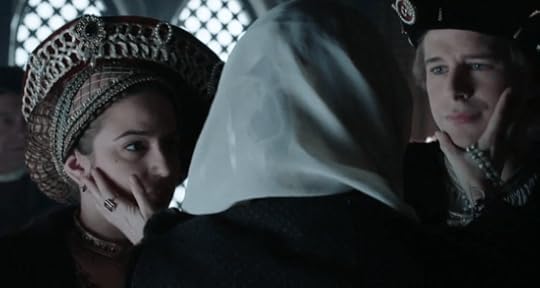 Charles and Eleanor meet their mother as portrayed in Carlos, Rey Emperador (2015)(Screenshot/Fair Use)
Charles and Eleanor meet their mother as portrayed in Carlos, Rey Emperador (2015)(Screenshot/Fair Use)Following the meeting with their mother, they continued their journey to meet with their brother Ferdinand, who had grown up in Castile. On 18 November, Charles made his entry into Valladolid alongside his brother and sister. Not much later, Ferdinand left for Central Europe, and Eleanor never saw him again. As she followed Charles around the lands he had inherited, Eleanor was also preparing for marriage. King Manuel I of Portugal had been widowed in March 1517, and Eleanor was to become his third wife. He had previously been married to two of Eleanor’s aunts, Isabella and Maria. Her grandfather, Maximilian, was opposed to the union and wrote, “As for the King of Portugal pursuing our daughter Lady Leonora, we have previously written to you our intention, namely that in no way can we advise marrying our daughter to the said King of Portugal, but if he wanted to have her for his eldest son, we would be very happy.”4 He was mainly opposed due to the King’s age – 49. Nevertheless, it was threatened that Manuel would marry Joanna la Beltraneja, a claimant to Charles’ throne, if Eleanor were not offered in marriage.
 Eleanor departs for Portugal as portrayed in Carlos, Rey Emperador (2015)(Screenshot/Fair Use)
Eleanor departs for Portugal as portrayed in Carlos, Rey Emperador (2015)(Screenshot/Fair Use)Eleanor dutifully accepted the groom placed before her, and she married King Manuel by proxy on 10 July 1518. She slowly prepared for her departure to Portugal, which took place on 5 October. Charles accompanied her for the first two days. In November, she crossed the Rio Sever into Portugal. On 24 November, she met her husband for the first time, and they were married by the Archbishop of Lisbon. Manuel had several living children from his second marriage, including Isabella, who would go on to marry Eleanor’s brother Charles in 1526. Upon meeting his children, Eleanor refused to let them kneel to her and embraced them warmly. She was at ease with them as she was close to their age.
Eleanor spent much of her time as Queen of Portugal, travelling between the various royal residences to avoid the plague. On 18 February 1520, she gave birth to her first child – a son named Charles. He lived for just over a year, dying on 15 April 1521. He was interred in the Jerónimos Monastery alongside two of his half-siblings, Maria and António. Eleanor was pregnant at the time of her son’s death, and a daughter named Maria was born on 8 June 1521.
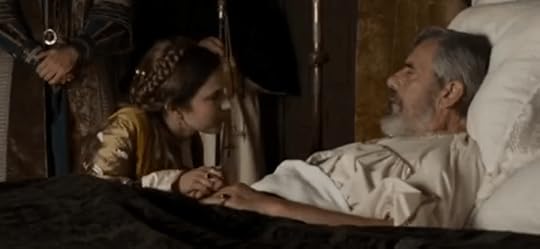 The death of King Manuel as portrayed in Carlos, Rey Emperador (2015)(Screenshot/Fair Use)
The death of King Manuel as portrayed in Carlos, Rey Emperador (2015)(Screenshot/Fair Use)Tragedy struck again in December 1521 when King Manuel fell ill with the plague. After a struggle of seven days, he died on 13 December 1521 at the age of 53. Eleanor was now a widow at the age of 23, and she withdrew to a convent to mourn her husband.
Part three coming soon.
The post Eleanor of Austria – “Foolishness of love” (Part two) appeared first on History of Royal Women.
November 14, 2024
Eleanor of Austria – “Wise, joyful, honest and kind in all things” (Part one)
Eleanor of Austria was born on 15 November 1498 in Brussels as the eldest child of the future Joanna, Queen of Castile and Philip I, King of Castile.
Joanna had been visited by her parents’ ambassador in August 1498, and he wrote to Queen Isabella, “She is so gentle and so beautiful and fat and so pregnant that the sight of her would console Your Highness.”1
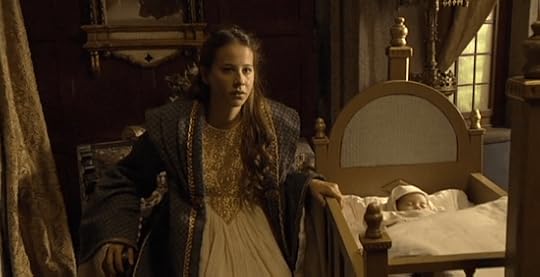 Joanna and Eleanor as portrayed in Isabel (2011)(Screenshot/Fair Use)
Joanna and Eleanor as portrayed in Isabel (2011)(Screenshot/Fair Use)Her father was clearly disappointed that his first child was a girl, and he told Joanna that she was to pay for the nursemaids and attendants herself. He said, “The Archduchess may provide for the places in the household of this child because it is a daughter. When God grants us a son, I shall provide for his household.”2 Three months later, Joanna’s accounts were “hoping from day-to-day that monseigneur the archduke would pay this expense, as he has still not done.”3
Philip’s father had been headed to Brussels to attend the baptism, but he left the Low Countries after learning that the child was a girl. Meanwhile, Joanna rested in a luxurious chamber of honour and received visitors from beneath a canopy of green damask. She held up a pretence of marital bliss, but things clearly were not right in the marriage. During this time, Joanna was second in the line of succession. Her brother John, his unborn child and her sister Isabella had died in quick succession, leaving only Isabella’s young son Miguel between her and her parents’s crown.
Despite their marital issues, Joanna and Philip had no problem producing more children. On 24 February 1500, Joanna gave birth to a son named Charles in Ghent, the future Holy Roman Emperor. Just five months later, young Miguel died, leaving Joanna as the future Queen. She was due to be sworn in as Princess of Asturias, but a third pregnancy postponed the journey. On 18 July 1501, Joanna gave birth to a second daughter named Isabella. Following Isabella’s birth, Joanna began to prepare for her journey to Castile to be sworn in as its heiress.
Joanna and Philip left Flanders in November 1501, leaving their three young children in the care of their paternal step-grandmother, Margaret of York. The children’s aya or governess was Anne of Burgundy, an illegitimate daughter of Philip the Good, Duke of Burgundy. Margaret took the children to Mechelen. Joanna fell pregnant again while in Castile, and so she remained behind after being sworn in as Princess of Asturias while Philip returned home to Flanders. He arrived in Flanders in November 1503. Joanna gave birth to Ferdinand on 10 March 1503 at Alcalá de Henares. In 1504, Joanna finally received permission to leave Castile to rejoin her husband and children. She left Ferdinand in the care of her parents. At this time, Joanna was reportedly already showing signs of mental illness, although the extent of this has been under debate. Nevertheless, she gave birth to a daughter named Mary in Brussels in 1505.
By then, her mother had died, and Joanna became the Queen regnant of Castile in 1504. In January 1506, Joanna and Philip again left for Castile, and a storm forced them to the English coast, which allowed Joanna to meet up with her sister Catherine, who had been married to Arthur, Prince of Wales, and widowed just months later. She would marry King Henry VIII in 1509. Once again, the children were left behind in Flanders, now in the care of Margaret of Austria, Philip’s sister, as Margaret of York had died in November 1503. Eleanor would never see her father again as Philip died suddenly in September 1506. Four months after Philip’s death, Joanna gave birth to her final child – a daughter named Catherine. Catherine and Ferdinand would grow up in Castile, while the other siblings grew up in the Low Countries. Citing her mental health, Joanna’s father had her confined in Tordesillas, where she would spend the rest of her life as a Queen in name only.
Under the care of her aunt Margaret, Isabella, Charles, and Eleanor received the best possible education one could imagine. Margaret of Austria also became Governor of the Habsburg Netherlands from 1507. Besides an education, Margaret instilled a love of music in the siblings, and they learned to play a number of instruments, such as the flute. Their religious education was entrusted to Pierre Dalma and Jean de Lampier. From 1509, they were also tutored by Adrian of Utrecht, the future Pope Adrian VI. Eleanor learned to speak and write French, which would be her mother tongue. She was raised to play a public role. Laurent Vital, secretary of the Burgundian state, wrote, “This beautiful young Princess, with her good grace, was so pleasant that everything suited her well, everything she did, and is a pleasure to see and hear, playing several instruments, like the lute, the manicordion, singing its part with others, dancing, chatting and talk, then one, then the other. In truth, it is a masterpiece as she is wise, joyful, honest and kind in all things.”4
During her early years, Eleanor had already been considered for several marriages. Suitors included the future Francis I of France, the future King John III of Portugal and the Duke of Lorraine. However, Eleanor remained on the bench for some while the marriages of her younger sisters were settled. Isabella married King Christian II of Denmark in 1514, while Mary married the future King Louis II of Hungary in 1515. There was a reason for this, and her grandfather, Maximilian, wrote to Margaret, “Dearest and most beloved daughter, I believe you still have in fresh memory that I once told you that our daughter, Lady Leonora, was kept from being married until one of the three Queens, namely those of France, England or Poland, will go from life to death. Now the Queen of Poland (Barbara Zápolya) has passed away and we are convinced that the King is of the opinion to ask both of us about the said Lady Leonora in marriage. On which we ask you to give us your opinion immediately, so that we can respond better to this, because I will be the first to be asked.”5
Part two coming soon.
The post Eleanor of Austria – “Wise, joyful, honest and kind in all things” (Part one) appeared first on History of Royal Women.
OBITUARY: Yuriko, Princess Mikasa
Yuriko, Princess Mikasa was born on 4 June 1923 as the daughter of Viscount Masanari Takagi and Kuniko Irie. She had an older sister, Kinuko, and two younger sisters, Momoko and Sayoko.
At the age of five, she enrolled at the Gakushein kindergarten and continued at the Gakushein school until her graduation in 1941.
That very same year, Yuriko became engaged to Prince Takahito, who had been granted the Mikasa title in 1935. He was the younger brother of Emperor Hirohito (Shōwa) of Japan, the grandfather of the current Emperor of Japan, and he was seven years older than her. It is unclear how they met, though it seems likely that the marriage was arranged. They were second cousins once removed.
Embed from Getty ImagesTheir engagement was announced on 29 March 1941, and their official engagement ceremony took place on 3 October. Their wedding followed on 22 October 1941.6 The New York Times reported, “The roaring of cannon from the great moat-encircled Chiyoda Castle, Emperor Hirohito’s residence in the centre of Tokyo, announced to the empire today the wedding of Prince Mikasa, youngest brother of the ruler, to Yuriko Takagi. The ceremonies, according to court etiquette, were conducted with ancient shinto rites before the nation’s holy of holies, the Kaski-ko-Dokoro, one of the three palace sanctuaries. Firing of the twenty-one-gun salute, in single explosions spaced a few seconds apart, announced the completion of the first stage of the ceremonies at 9 A.M.”7 Upon marriage, she became Her Imperial Highness The Princess Mikasa.
Embed from Getty ImagesThe couple went on to have five children together: Princess Yasuko (born 1944), Prince Tomohito (born 1946 – died 2012), Prince Yoshihito (born 1948 – died 2014), Princess Masako (born 1951) and Prince Norihito (born 1954 – died 2002). They performed public duties for the imperial family, and Prince Mikasa also served in the army during the Second World War. After the Second World War, Prince Mikasa reportedly supported an early abdication by Emperor Hirohito.8 In 1946, the peerage system was abolished, which meant that Yuriko’s family was no longer noble. In 1948, her father died, reportedly by suicide.9
Yuriko held several patronages and served as Vice President of the Japanese Red Cross, among other things. She also attended family-related events.
Embed from Getty ImagesPrincess Yuriko outlived all three of her sons and her husband. Her youngest son, Norihito, died in 2002 at the age of 47 following a cardiac arrest. He left behind a wife and three daughters. Her eldest son, Tomohito, died of cancer in 2012 at 66. He left behind a wife and two daughters. Her middle son, Yoshihito, died in 2014 of a heart attack at the age of 66. He was unmarried. Her two daughters married outside of the imperial house and gave up their imperial titles. Yasuko has a son and three grandchildren, while Masako has two sons and a daughter. Three of her granddaughters, through her sons, are still members of the imperial family. The two others have married outside of the family.
Embed from Getty ImagesOn 22 October 2016, Yuriko and her husband celebrated their 75th wedding anniversary as he was hospitalised. He died five later at the age of 100. Princess Yuriko visited his grave every month on the 27th. She suffered several health issues over the years and was diagnosed with COVID-19 in 2022.
As she celebrated her 100th birthday, she lived a quiet life in Tokyo. She was the oldest living royal from a reigning family.
Yuriko, Princess Mikasa died on 15 November 2024.
The post OBITUARY: Yuriko, Princess Mikasa appeared first on History of Royal Women.
Yuriko, Princess Mikasa has died at the age of 101
Yuriko, Princess Mikasa has died today at the age of 101.
She died in the early hours of Friday morning, local time. The official cause of death has been given as old age.
“I cannot help but feel saddened to hear of the loss. I extend my heartfelt condolences along with other Japanese citizens,” Prime Minister Shigeru Ishiba said in a statement.
The 101-year-old Princess had been hospitalised since March after suffering a stroke and pneumonia. She was then treated at an intensive care unit at St. Luke’s International Hospital in Tokyo.
She was moved to a private room in September and had been undergoing rehabilitation.
According to the Imperial Household Agency on 8 November, the Princess’s condition had deteriorated, and tests showed a decline in function throughout her body, including her kidneys and heart.
Princess Akiko immediately travelled from the airport to visit her grandmother. In addition, her daughter-in-law, Hisako, Princess Takamado, had cancelled an upcoming visit.
No announcements have yet been made concerning funeral arrangements.
The princess is the widow of Prince Mikasa, a younger brother of the late Emperor Hirohito. They had five children together: three sons and two daughters. All three sons have predeceased Princess Yuriko.
The post Yuriko, Princess Mikasa has died at the age of 101 appeared first on History of Royal Women.
November 12, 2024
Dorothea of Denmark – Openly forsaking the faith (Part three)
On 18 May 1535, the proxy wedding took place in Brussels. Dorothea set out for Heidelberg, where she arrived on 8 September. Frederick rode out to meet her and escorted her to Heidelberg Castle. On 9 September, the Bishop of Spires celebrated a nuptial mass. Afterwards, Frederick and Dorothea made their home at Neumarkt. Frederick soon learned that Emperor Charles had “no great affection for the enterprise of Denmark” and he had “embarked on a new and tempestuous ocean.”1 They never managed to recover Dorothea’s inheritance. Dorothea’s father had been a prisoner in Denmark since 1531.
Luckily, it proved to be a happy marriage otherwise. Dorothea was loved by her subjects, but she turned out to be quite a spendthrift, like her husband. They often went out together, even climbing mountains. She tried desperately to conceive a child and went on pilgrimages and wore holy girdles.
Christina returned to Flanders in 1537 after being widowed in 1535. She had requested to travel by way of Dorothea’s home, as she had not seen her sister since the spring of 1534. This request was granted, and the two sisters met in Heidelberg in November 1547. Christina was magnificently entertained with banquets, jousts and dances. They had so much that Christina was invited to stay over for Christmas. However, Mary demanded that Christina return to Flanders as quickly as possible, and so the sisters parted ways again. Christina remarried in 1541 to the future Francis I, Duke of Lorraine. Her youngest daughter was named Dorothea after their aunt, but she would be widowed again just one month after the younger Dorothea’s birth.
Dorothea and Christina remained in regular contact. During one such visit to Lorraine in 1551, Dorothea rode back in a chariot after a hunt, which got stuck in the mud because of heavy rain. The carriage had jolted in the mud, leaving the ladies covered in it, and Dorothea had a scratch on her face as well. Dorothea laughed off the incident and managed to return on horseback.2
Dorothea was widowed on 26 February 1556 when Frederick died at the age of 73 at Alzey. She had nursed him throughout his final illness. Three weeks before Frederick’s death, Dorothea had sent for his nephew and heir, Otto Henry, Count Palatine. He, too, remained with Frederick until his death. Frederick’s body was returned to Heidelberg, where his body lay in state for three days. Then his body was carried down to the Church of the Holy Spirit where he was interred. Christina had wanted to immediately visit her widowed sister, but her request was denied.
Dorothea had become well-known for her Lutheran leanings, much to the annoyance of her family. One observer wrote, “The Electress Dorothea is known to be a Lutheran and against the Emperor and is as much hated here as her sister Christina is beloved.”3 Emperor Charles asked his son to invite Dorothea to come live in Brussels, “lest one of our own blood should openly forsake the faith.”3 Christina was also sent in to persuade Dorothea, but she refused them all. In the end, she settled in Neuburg, where she was able to practise her faith the way she wanted.
In 1561, Dorothea and Christina’s father died in prison in Denmark, and Dorothea assumed the title of Queen of Denmark, although it was an empty title. Christina reportedly visited her sister to convince her to pass her claim to her nephew, Christina’s son.
Dorothea reportedly died suddenly the following year at Neuburg. She was interred next to her husband, and her tomb had the following inscription, “To the most noble Lady, Dorothea, Countess Palatine and Queen of Denmark, Sweden and Norway, the beloved consort of the Elector Frederic II. This tomb was raised by Frederic III by the Grace of God Elector Palatine, in the year 1562, as a token of love and gratitude to this his most dear and excellent kinswoman.”4 This tomb was destroyed in 1693 when French armies sacked the town of Heidelberg.
However, many other sources state that Dorothea died on 31 May 1580.5 We can only assume the majority here is correct as we no longer have the tomb to rely on. There is also a reference to her writing a letter in 1567.6 However, there is also a reference of an inscription from 1563 referring to Christina as Queen of Denmark, Sweden and Norway.7
The post Dorothea of Denmark – Openly forsaking the faith (Part three) appeared first on History of Royal Women.
November 11, 2024
Let’s get it right – Camilla is The Queen
When Queen Elizabeth II died, the following statement was issued, “The Queen died peacefully at Balmoral this afternoon. The King and The Queen Consort will remain at Balmoral this evening and will return to London tomorrow.” 1
Now that Charles is King, Camilla automatically took on the female equivalent of her husband’s rank and status and thus became Queen. As she is not a Queen in her own right, her role is that of Queen consort. In the United Kingdom, a Queen consort is addressed as Her Majesty The Queen. However, for some reason, Buckingham Palace initially insisted on referring to Camilla as “Her Majesty The Queen Consort.” 2
As confirmed when Lady Elizabeth Bowes-Lyon married the then Duke of York, “In accordance with the settled general rule that a wife takes the status of her husband Lady Elizabeth Bowes-Lyon on her marriage has become Her Royal Highness the Duchess of York with the status of a Princess.” 3 Thus, when Camilla married the then Prince of Wales, she became Princess of Wales, Duchess of Cornwall, etc. She chose to use the Duchess of Cornwall title as the Princess of Wales title was still strongly connected to Charles’s first wife, Diana. This doesn’t mean that she wasn’t legally The Princess of Wales. You’ll also note that none of these titles includes the word “Consort.”
While it has been said that including the word consort was meant to avoid confusion with the late Queen, you’ll still find people claiming Camilla is “only” a Queen consort two years later.
So what is with this “Queen Consort Camilla” business? We cannot claim that we don’t know how it’s done. Even after the death of Queen Victoria after a reign of 63 years, Queen Alexandra was only briefly referred to it. Queen Mary and Queen Elizabeth The Queen Mother were not, as far as I can tell, referred to as “Her Majesty The Queen Consort”, and if they were, it must have been only briefly. We know Camilla is not a reigning Queen, as there is a King. So, we cannot claim confusion with the previous Queen (regnant).
Queen Elizabeth II herself added to the confusion when she released a statement saying, “It is my sincere wish that, when that time comes, Camilla will be known as Queen Consort as she continues her own loyal service.” 4 Do note the “The” missing from there. This clearly indicates that she did not intend for this to be taken as Camilla’s exact title. Camilla was always going to be a Queen consort, as she is the wife of a King and her correct form of address is Her Majesty The Queen.
The post Let’s get it right – Camilla is The Queen appeared first on History of Royal Women.
November 10, 2024
Dorothea of Denmark – A royal bride (Part two)
On 5 March 1526, Margaret returned to Mechelen with John, Dorothea and Christina. Margaret wrote to Charles, “Henceforth, Monseigneur, you will have to be both father and mother to these poor children, and must treat them as your own.”1 For the next four and half years, Margaret made sure that the children lacked nothing. They lived under her roof in Mechelen; she arranged for their education, and she hardly went a day without seeing them. Her death on 1 December 1530 was greatly mourned by the three children. John was the chief mourner at her funeral and he rode at the head of the procession.
Margaret was replaced as governor of the Habsburg Netherlands by her niece and Emperor Charles’s sister, Mary of Austria. Mary arrived in Mechelen with Charles in March 1531 and met her nieces and nephew for the first time. Dorothea and Christina, who were nine and ten years old, were left at court while John joined their aunt and uncle on a progress through the provinces.
The family gathered in Brussels to celebrate Christmas in December 1531 with Emperor Charles. Dorothea was sat next to her illustrious uncle during the festivities. Two weeks later, Emperor Charles left Brussels and took John with him on his trip to Regensburg, where the Imperial Diet was set to open in May. The weather proved to be quite terrible, and many fell ill, including the Emperor and Prince John. Charles left town to take the waters and returned to find John delirious with a fever. The doctors soon gave up all hope, and Charles left again, saying he could not bear to see him die.2 John fell into unconsciousness and died in the early hours of 11 August 1532. He was only 14 years old.
Charles wrote Mary to inform her of John’s death and added, “I am writing to my little nieces, as you see, to comfort them. I am sure that you will try and do the same. The best remedy will be to find them two husbands.”3 Dorothea and Christina were still young, but their future marriages had already been under discussion for some time.
For Dorothea, a marriage with her second cousin, James V, King of Scots, had been discussed for some years, but he ended up in a French alliance. King Henry VIII of England’s illegitimate son, the Duke of Richmond, had been offered to either Dorothea or Christina, but this was rebuffed due to his being illegitimate. Dorothea had inherited her brother’s claim to Denmark, and King Frederick of Denmark offered the hand of his second son, also named Prince John, and promised to name him heir to Denmark. However, Charles and Mary were reluctant to deal with someone whom they considered a usurper.
In 1532, Dorothea received an offer from Francesco Sforza, Duke of Milan, but Emperor Charles declined, saying she had already been promised to the King of Scots. Christina was considered to be too young, but when Francesco renewed his request the following year, it was granted. Nevertheless, Mary had grown close to the two girls, and she was mortified that the 12-year-old Christina was given in marriage to the 39-year-old Duke of Milan, and she tried to delay Christina’s departure as long as possible. Once married and settled, Christina wrote to Dorothea, “We are as happy and contented as possible.”4 Christina was widowed on 2 November 1535, just two years after the proxy wedding.
By then, Dorothea had also been married. A few months after Christina’s wedding, another suitor came forward. He was Frederick II, Count Palatine of the Rhine, and later Elector Palatine. He had once also asked for the hand of Emperor Charles’s sister, Eleanor. He also requested the hand of one of King Ferdinand’s (later Ferdinand I, Holy Roman Emperor, brother of Emperor Charles) daughters, but he claimed they were too young. However, he was unwilling to lose a valuable ally and suddenly proposed the hand of the 12-year-old Dorothea. He believed Frederick could be most useful in recovering Dorothea’s lost inheritance. Frederick suddenly hesitated because of his age (he was 50 in 1533) and the daunting task of trying to recover the Nordic kingdoms. But in the end, he agreed after Charles promised a dowry of 50,000 crowns. The messenger who brought Frederik the news exclaimed, “I bring my lord a royal bride, a most gracious Kaiser, and a sufficient dowry.”5
Part three coming soon.
The post Dorothea of Denmark – A royal bride (Part two) appeared first on History of Royal Women.
November 9, 2024
Book News Week 46
Book News week 46 – 11 November – 17 November 2024
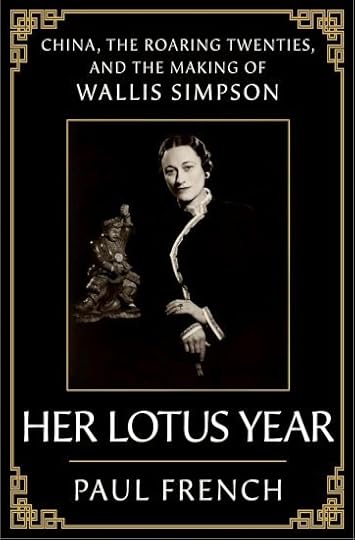
Her Lotus Year: China, the Roaring Twenties, and the Making of Wallis Simpson
Hardcover – 12 November 2024 (US) & 14 November 2024 (UK)
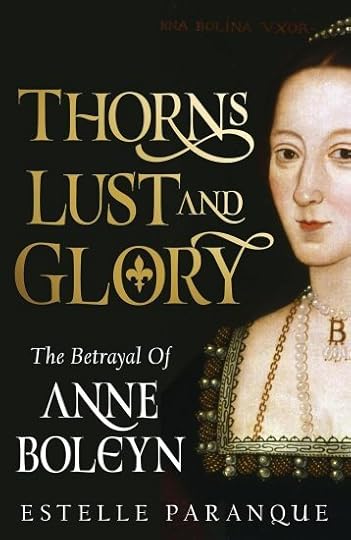
Thorns, Lust, and Glory: The Betrayal of Anne Boleyn
Hardcover – 12 November 2024 (US)
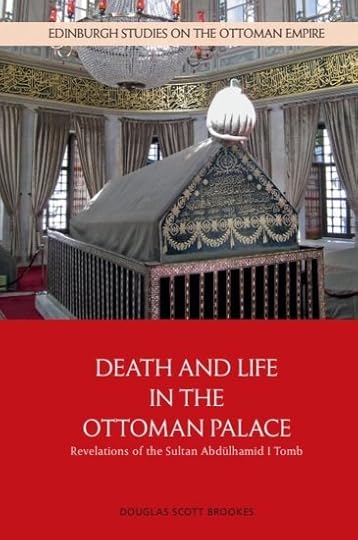
Death and Life in the Ottoman Palace: Revelations of the Sultan Abdülhamid I Tomb (Edinburgh Studies on the Ottoman Empire)
Paperback – 13 November 2024 (UK)
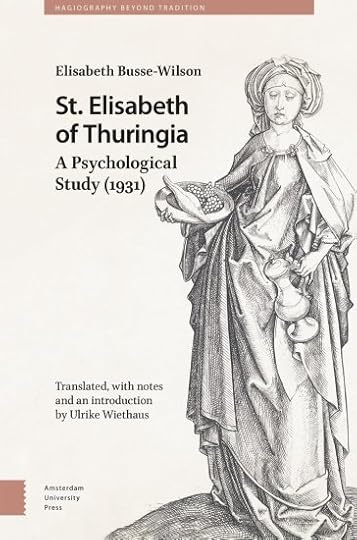
St. Elisabeth of Thuringia: A Psychological Study (1931) (Hagiography Beyond Tradition)
Hardcover – 14 November 2024 (UK & US)
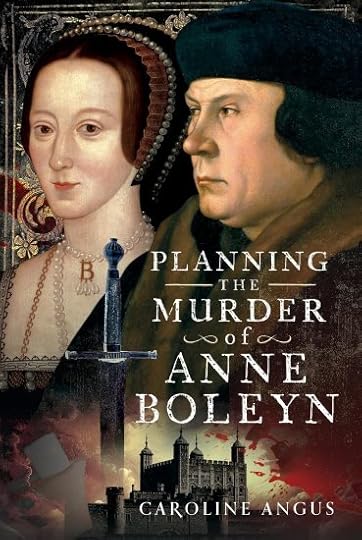
Planning the Murder of Anne Boleyn
Hardcover – 11 November 2024 (US)
The post Book News Week 46 appeared first on History of Royal Women.
Dorothea of Denmark – Deprived of her crown (Part one)
Dorothea of Denmark was born on 10 November 1520, the daughter of Isabella of Austria and King Christian II of Denmark, Norway, and Sweden. Her mother was the second daughter of Joanna, Queen of Castile, and thus a sister of Charles V, Holy Roman Emperor.
Dorothea was their fourth child, but twin boys had died shortly after their birth. Her elder brother, John, had been born in 1517 and a younger sister named Christina would follow in 1522. These were troubled times for their father as there had been a revolt in Sweden, upon which Christian decided to travel to the Low Countries and placed the regency in Isabella’s hands. He met with Isabella’s aunt and brother in Brussels, as well as Isabella’s step-grandmother, Germaine of Foix. His journey was without success, and the situation continued to spiral out of control.
Just weeks after Christina’s birth, Isabella wrote to her aunt Margaret of Austria, Governor of Habsburg Netherlands, asking for help with the rebels. She wrote, “We have sad news from my lord in Jutland. The nobles there have rebelled against him and seek to deprive him and our children of their crown and their lives. So we entreat you to come to our help, that we may chastise the rebels.”1
On 20 January 1523, Christian was officially deposed as King of Denmark and Norway and replaced by his uncle, Frederick. Christian decided to flee with his family. Isabella, John, Dorothea and Christina went on board the Lion, even though Frederick begged her to remain in Denmark, assuring them of their safety. Christian still had the popular support, and many watched as the King and his family sailed away on 13 April. The children were left with Isabella’s aunt in Mechelen while Isabella and Christian continued on to Greenwich, which they reached on 19 June, and they were met by Cardinal Wolsey, who introduced them to King Henry and Queen Catherine, who was also Isabella’s aunt. However, Henry told Christian he had made a mistake by abandoning his subjects and advised him to return home. He later wrote to Emperor Charles, “For this perfidy of the King’s subjects is a most fatal example, if for the most trifling cause a Prince is to be called in question, and expelled and put from his crown.”2
Nothing more could be done in England, and so Isabella and Christian returned to the Low Countries in early July. Isabella returned to her children in Mechelen, while Christian went to Antwerp to raise ships with aid for Copenhagen. After a fight with Margaret, he suddenly left for Germany. Isabella joined him in Germany as he tried to find help, and Isabella even spoke at the Nuremberg Diet. Minister Hannart wrote to Emperor Charles, “Everyone here is full of compassion for the Queen, but no one places the least trust in the King. If it were not for her sake, not a single man would saddle a horse on his behalf.”3
During a congress in April 1524, a proposal was made that Prince John was to be recognised as Frederick’s successor, but Christian angrily rejected this offer. He soon realised the hopelessness of his cause. Isabella’s health had suffered during these last years, and Christian took her to Aachen to go to the waters. The family then settled at Lierre, halfway between Mechelen and Antwerp, at the end of 1524. While they received an allowance, Isabella was eventually forced to cut up her husband’s old robes to make clothes for the children. When her health required a second visit to Aachen, she declined due to the vast expense.
At the doctor’s suggestion for a change of air, she moved to Swyhnaerde near Ghent, where she soon became so weak that she could no longer leave her room. On 19 January 1526, Isabella received the last sacraments from the priest of Swynaerde, and she commended her children to Margaret’s care. She died a few hours later, still only 24 years old.
Christian took his children from Ghent following Isabella’s death and refused to give them up to Margaret until she had paid all of his debts, including the funeral expenses. Emperor Charles wanted the children returned to Margaret’s care “because of the King’s heretical leanings.”4 After many discussions, Margaret eventually rode to Lierre herself to convince Christian to leave the children with her. He had already packed up most of his belongings, and he intended to leave for Germany. She finally managed to convince himself after agreeing to pay some of the debts. Christian left for Germany intending to raise an army to try and reclaim his kingdoms.
Part two coming soon.
The post Dorothea of Denmark – Deprived of her crown (Part one) appeared first on History of Royal Women.



